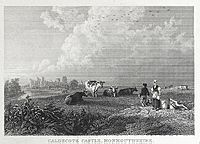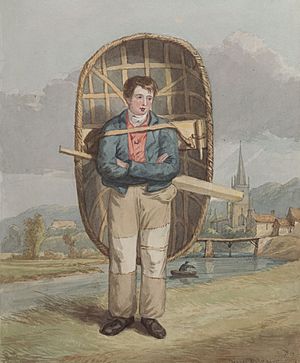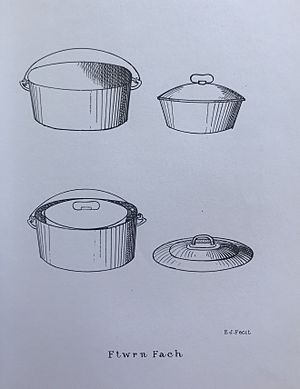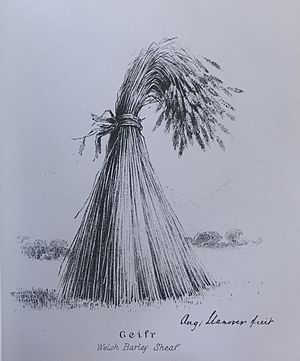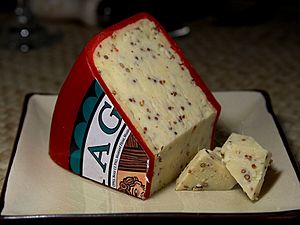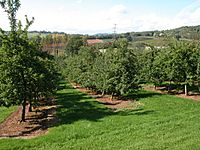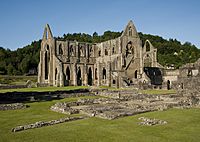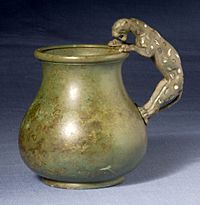Cuisine of Monmouthshire facts for kids
Monmouthshire is a county in Wales with a rich history of delicious food! Much of its food story is linked to Lady Llanover, also known as Lady Augusta Hall. She wrote one of the first Welsh cookbooks called First Principles of Good Cookery. This book is special because it features a made-up Welsh hermit who shares cooking tips with a traveler exploring Wales.
A writer named Bobby Freeman thought the book was very important. In 1991, she helped get it printed again, adding an introduction about Lady Llanover's life and why the book matters. Lady Llanover loved Welsh food and served it often at her home, Llanover Hall. She was famous for being a great host, and a motto hung in her dining room:
Thrift is beneficial to all
And is the father of wealth
This means saving money is good for everyone and helps you become rich!
Food expert Gilli Davies points out that while some recipes in Lady Llanover's book are truly Welsh, others came from Lincolnshire, where Lady Llanover grew up.
Monmouthshire has three main farming areas. The middle and eastern parts have big valleys from the Severn, Wye, and Usk rivers. This land is good for growing crops and has gentle hills, perfect for market gardens (places that grow vegetables to sell) and vineyards (places that grow grapes for wine). The southern part of the county is next to the Bristol Channel and has areas of moorland and marsh, like Wentlooge and Caldicot. Long ago, monks from Goldcliff Priory owned this land. They drained it and built sea walls to stop floods. The northern and western parts are uplands with thin soil, best for hill farming. This area includes the Ebbw and Sirhowy valleys and the Black Mountains.
According to Davies, Monmouthshire has done a great job growing different kinds of food, like grapes for wine (viticulture), gardening (horticulture), and organic farming. Special food businesses have also done well because of good transport links and being close to markets in England. This helps get food to people and has led to many high-quality restaurants. Davies says the food in Monmouthshire has "a rare and appealing quality."
Contents
- Meat Dishes: Lamb, Beef, and Pork
- Poultry and Game: From Farm to Table
- Fish: From Rivers to the Sea
- Vegetables: Fresh from the Land
- Sauces and Condiments: Flavorful Additions
- Bread and Cakes: Baking Traditions
- Milk, Cheese, and Ice Cream: Dairy Delights
- Fruit and Puddings: Sweet Treats
- Drinks: From Wine to Cider
- Restaurants: Places to Eat
- Festivals: Celebrating Food
- Images for kids
Meat Dishes: Lamb, Beef, and Pork
Tasty Lamb and Mutton from Monmouthshire
Lamb and mutton are popular in Monmouthshire, especially in stews, broths, and casseroles. These meats come from the hill farms in the north of the county. They have been a favorite in local hotels and inns since people started visiting the area.
In the 1880s, an American writer named Wirt Sikes visited Wales. He wrote about his travels and praised the lamb in Monmouthshire. He said the lamb chops at the Old Croft Inn in Caerleon were "done to a turn... with the true Welsh tenderness and juice." However, at The Beaufort Arms in Monmouth, Sikes joked that no matter what he asked for, he always ended up with chops!
Chef Franco Taruschio notes that Welsh lamb can be on menus all year round. Lowland lamb is ready in spring, upland lamb in summer, and mountain lamb from late summer to autumn. Mountain lamb grows up outdoors, eating grass and herbs.
Before the Victorian era, Welsh Mutton Hams were a common food. Bobby Freeman says old Welsh mutton recipes "make one's mouth water" and suggests they could be adapted for modern lamb dishes.
In Lady Llanover's book, a traveler dines with a hermit and talks about Welsh mutton:
"Although real Welsh mutton was admitted by all epicures, and by medical men, to be the very finest for flavour, and the lightest of digestion of all the breeds of sheep known in Great Britain, very few prizes were ever given for the encouragement and preservation of so invaluable a breed of animals"
But like Sikes, the traveler found that not all inns served good mutton:
"..even at Welsh inns, during his last absence, he had been sickened by large coarse mutton, though within a mile of mountains, where the best Welsh sheep were to be had, and could alone live and flourish. He added that, at private houses, the same complaint may often be made in Wales as well as in London, from whence the rich, nevertheless, send abroad for all sorts of foreign luxuries for their table, on which the best Welsh mutton is seldom ever found"
Lady Llanover's book tries to fix this with recipes like Boiled Shoulder of Mutton. This recipe involves boiling mutton for two and a half hours with onions, celery, marjoram, and a small sprig of thyme. There's also a recipe for Welsh Lamb Pie. For this, lamb neck bones are cooked with vegetables overnight. The next day, pastry is made, the meat and vegetables are added, and after baking, melted jelly from the meat is poured in.
Annette Yates suggests a recipe for Welsh Mountain Lamb with Honey, Rosemary, and Cider. She says lamb with honey and rosemary is a classic combination, and cider adds a nice touch. The dish is cooked until the lamb is very soft. The lamb's sweet juices become golden and caramelized from the honey. Yates also notes that many cider makers are in this part of Wales.
Monmouthshire Broth is a local recipe using lamb neck. The neck simmers in a pot for two hours with chopped onions and sliced carrots. Potatoes are added later, and chopped parsley is sprinkled on top as a garnish when served. Monmouth Stew (Stiw Mynwy) is a lamb stew with leeks and pearl barley. Parsley, thyme, and a bay leaf are added for seasoning.
In her book Welsh Country Puddings and Pies, Bobby Freeman writes about Anne Hughes, a successful farmer near Chepstow. Anne would make a special May Day Pie with meat and fruit for her farm workers. These pies were like a Cornish pasty, filled with cooked meat (likely mutton or lamb), finely chopped apples, pears, onions, lemon thyme, rosemary, pepper, and salt. Anne Hughes kept a diary in 1796, recording her farm life and favorite recipes.
Cattle and Beef in Monmouthshire
Cattle have been important in Welsh farming since Roman times. Welsh Black cattle is a traditional breed known for its flavorful meat. Amanda Wragge uses this meat in her Black Beef Burger recipe, which includes egg, breadcrumbs, ginger, and cumin for a spicy kick. While Welsh Black cattle are popular, they only make up about 2% of Wales's beef. Other breeds include Aberdeen Angus, Hereford, and Limousin. You can find traditional butchers in towns like Abergavenny, Raglan, and Monmouth.
Pork and Ham Traditions
Pork has been eaten in Wales for a very long time, with the pig even mentioned in ancient Welsh laws. Until recently, most country families kept a pig, often letting them feed in woodlands. Lady Llanover's cookbook gives detailed instructions for curing ham. In Welsh Calendar Cookbook, Gilli Davies shares a recipe for Braised Monmouthshire Pork with Savoury Welsh Cakes, where the Welsh Cakes are used as a side dish.
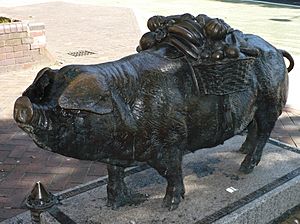
Goat Meat: A Welsh Delicacy
Goat meat stayed popular in Wales long after people stopped eating it much in England. Goat hams were even called 'hung venison'. In early medieval times, goat was eaten instead of bacon. Thomas Pennant noted that young goats, called kids, were "a cheap and plentiful provision in the winter months" in Wales. While goat meat was once seen as less fancy than venison, Bobby Freeman says the best goat is sweet and fatty and makes an excellent pasty. Chef Franco Taruschio has a recipe for Kid with Orange, Marsala, and Coriander. He says:
"We always have kid on the menu in the spring. So many people nearby have goats either for their milk or for their wool. If they have too many billies we have them….Kid meat is a sweet tender meat with hardly any fat."
Poultry and Game: From Farm to Table
Farm-Raised Birds
Poultry (farmed birds) is still an important part of food production in Monmouthshire. Turkey, chicken, and duck are raised organically on some farms.
Lady Llanover's book has a recipe for Welsh Salt Duck, which Bobby Freeman calls "a most successful and unusual dish." Annette Yates says it's probably the most famous duck dish in Wales. The recipe involves salting a whole duck for three days before cooking. Freeman wonders if the duck was salted to make an older bird tender or to help it last longer. She notes that Welsh Salt Duck seems to have been mainly eaten in the Welsh Marches (the border area with England). It's a delicious dish that's not very well known. The duck meat is tender and lightly salted, but low in fat because the fat is removed when the water is drained. Freeman suggests saving this water as a stock for lentil soup. The duck can be eaten with a Laverbread Sauce or cold with a salad. Yates says cold slices of Welsh Salt Duck were often served with a tart fruit sauce made from damson, plum, or bilberry. When Lady Llanover's book was republished, Bobby Freeman asked Chef Franco Taruschio to create a restaurant menu based on its recipes. With help from Elizabeth David, he made a menu featuring Welsh Salt Duck as the main course.
Lady Llanover's book also includes a recipe for The Hermit's Chicken and Leek Pie. However, Bobby Freeman thinks this recipe isn't from ancient Welsh cooking traditions but probably from a later time, perhaps made by the wives of wealthy farmers. Maesmawr Farm, which specializes in poultry farming in Glascoed, has its own recipe for Turkey and Leek Pie. Gilli Davies includes this recipe in her book. It contains chopped turkey, ham, leeks, and watercress. The leeks are cooked with butter until soft, then a sauce of flour, cream, and wine is added. After simmering, the mixture is poured into a pie dish with mustard, grated lemon peel, grated cheese, and lemon juice. It's then covered with pastry and baked until golden.
Wild Game from the Countryside
Game animals are also plentiful in Monmouthshire. These include teal, woodcock, partridge, hare, rabbit, and venison. Chef Franco Taruschio says:
"When the game season starts with red grouse on 12 August, it always brings a sense of excitement. This must be because one never knows what is going to arrive from the shoots. Game is plentiful around here; ….Pheasants are so abundant one can see them in almost every field."
Taruschio has a recipe for Guineafowl Cooked in Clay. He found a seam of clay on a building site in the 1960s and used it to cook the bird, explaining it's a very old cooking method. He stresses that the clay needs to be the same thickness all around the bird, with no holes, so it cooks evenly.
Fish: From Rivers to the Sea
Ancient Fish Eating Habits
Monmouthshire had important Roman settlements. Cockles and oysters were popular shellfish eaten during this time. Archeologists have found huge amounts of shells at Roman sites. However, after the Romans left Wales, fish became less popular. Bobby Freeman suggests this was because Celtic Christianity linked fish to paganism and the goddess Venus.
Salmon and Trout in Monmouthshire Rivers
The Severn, Wye, and Usk rivers are famous for their salmon and trout. Gilli Davies notes that the Wye is considered the most important river for salmon in England and Wales, and one of the best for fishing in Britain. In the 1980s, about 8,000 salmon were caught by fishing rod on the Wye each season. While numbers have since decreased, fishing tourism still brings a lot of money to the local economy, with hotels and restaurants catering to recreational fishing.
On the Severn, many salmon were caught by net and fish trap in the 1800s. For example, 22,500 fish were caught in 1870. However, by the 1900s, these numbers had dropped significantly.
Putscher fishing, using removable basket traps, was once common along the Monmouthshire and Gloucestershire banks of the Severn. They are still used in places like Porton and Goldcliff. At Goldcliff, fish were collected and sent by train to London. A different type of basket, called a putt, was less common and needed more skill to weave. These were only used on the Severn estuary and were abandoned in the 1920s.
The Severn Estuary and the Usk and Wye estuaries were also fished using lave nets (Y-shaped nets). Other nets like clenching nets and stop-nets were also used. Coracle fishing (using small, round boats) also took place on these rivers but ended in the 1930s. The coracle used on the Usk and Wye was called the Monmouthshire truckle. Drift netting and seine fishing were also done on the wider parts of these rivers where the current is stronger.
In Wales, poaching (cooking gently in liquid) was the usual way to cook salmon, often in milk with a bay leaf. The salmon would be served hot with parsley sauce or eaten cold with bread and butter. Bobby Freeman says salmon poached in milk and eaten cold with cream is "an idea borrowed from the kitchens of Heaven!" Lady Llanover's book explains how to "crimp" salmon. This was a common practice in Victorian times to make the flesh firm before the white "curd" appeared, which could make the fish oily. Crimped salmon was served with a strong sauce. Lady Llanover recommended a Granville sauce, named after Sir Richard Granville, an ancestor of hers.
Sea trout (called Sewin in Wales), trout, and grayling are also caught in Monmouthshire's rivers. Grayling tastes excellent but doesn't keep well, so it should be eaten soon after being caught. Grilled Grayling is a simple way to cook it, adding herbs like chervil, chives, tarragon, or parsley, along with butter, salt, and pepper. Trout farms in the county, like Crucorney Trout Farm, sell farmed trout.
Eels: A Local Delicacy
Another important freshwater fish from Monmouthshire is the eel. Gilli Davies notes that fishing for young eels, called elvers, along the Wye is a very old tradition. Elvers are caught in special nets that look like giant lacrosse sticks. Elver fishing depends on the moon's phase. Eels breed in the Sargasso Sea and travel across the Atlantic Ocean to swim up Monmouthshire's rivers, where they live most of their lives. When fully grown, they return to the Sargasso Sea to breed again. The Wye is a favorite river for eels, probably because of its tides. As the eels swim along the river banks, local fishermen scoop them out with old-looking nets. Davies says fishermen return to the same spots every year to catch the tiny eels moving up the Wye.
Elvers are considered a special treat. Huge numbers were caught every year in the lower Severn Valley as they entered the river with the Severn bore (a tidal wave). The Bristol Channel's shape acts like a funnel, meaning more elvers enter the Severn than any other British river. Because of this, elvers have been eaten as a delicacy in areas near the tidal Severn for centuries. The traditional way to eat elvers in Wales is to cook or fry them in bacon fat for breakfast.
Fresh fish is often on the menu at Monmouthshire restaurants. For example, The Crown at Whitebrook serves Smoked Sewin and Salmon terrine. This dish has thin layers of smoked Sewin at the bottom and sides of a terrine dish. The salmon is poached in an onion and wine stock, then flaked and mixed with cucumber, carrot, lemon zest, herbs, and the rest of the Sewin. This mixture fills the terrine and is topped with quail eggs. The terrine is chilled for 12 hours, then served with salad and toast from whole wheat bread.
Vegetables: Fresh from the Land
Monmouthshire grows many fruits and vegetables, including mushrooms, tomatoes, leafy greens, and winter root vegetables. The sheltered valleys of the Usk and Wye have traditionally been used for growing wheat, potatoes, peas, beans, and turnips. The eastern part of the county has most of the arable land (land suitable for growing crops). In the north and north-west, barley and oats are the main crops. Monmouthshire is also a big producer of potatoes.
Market gardening is important, especially along the Wye valley and around Newport. Here, fruit farms let customers pick your own produce.
Chef Franco Taruschio, a restaurateur, only used local, seasonal vegetables. This meant his menu changed with the seasons. Purple broccoli and broad beans were used in spring, zucchini in summer, and pumpkins in autumn. In winter, parsnips were cut into chips, then blanched and deep-fried and sprinkled with salt. The restaurant got its vegetables directly from local farmers. Taruschio also went foraging for wild mushrooms:
"We have three spots which have become firm favourites for our mushroom gathering forays, and each spot has a breath taking beauty. Our most prolific area is a wood in the Black Mountains. The terrain is difficult but the beauty of that wood and the baskets of porcini, chanterelles, pied-de-mouton and trompette de la mort more than compensate for the aching limbs and sore back. The smell of the birch trees, the vast variety of mosses, the sun slanting through the branches in little patches, the sound of the waterfalls gushing down to the brook below and the smell of the mushrooms transport one away."
The leek is the symbol of Wales and is linked to Saint David's Day. This is even mentioned in Shakespeare's play Henry V, where Welsh soldiers wear leeks in their Monmouth caps:
Fluellen: "If your Majesty is remembered of it, the Welshmen did good service in a garden where leeks did grow, wearing leeks in their Monmouth caps, which your Majesty knows, to this hour is an honourable badge of the service, and I do believe, your Majesty takes no scorn to wear the leek upon Saint Tavy's day".
King Henry: "I wear it for a memorable honour; for I am Welsh, you know, good countryman".
King Henry V was born in Monmouth Castle, which is why he was sometimes called Henry of Monmouth.
Sauces and Condiments: Flavorful Additions
Bobby Freeman notes that Hot Sour Pickle Confection (Suryn Cyffaith Poeth) is an ancient Welsh sauce. It has roots in 'liquamen' or 'garum', an early Roman and Greek condiment made from salted, rotting fish. This sauce was used instead of salt. When the Romans left Wales, the sauce continued to be used. Freeman says one surviving recipe is surprisingly similar to HP Sauce. This recipe is found in the book Croeso Cymreig and was likely kept in a household cookbook from a Welsh country house.
Rowan jelly is a traditional condiment for mutton and lamb. Freeman says it has a more subtle flavor than redcurrant sauce and has been served for a very long time. She describes rowan berries, when ripe, hanging "like scarlet curtains along the deep, narrow lanes" of Wales and says they make a "lovely deep, scarlet red jelly."
Bread and Cakes: Baking Traditions
Monmouthshire has the most land used for wheat production in Wales because of its large, fertile river valleys and sheltered location. Generally, Wales is too wet and mountainous for big wheat farms, but Monmouthshire's geography provides the rich soil and dry, sunny weather wheat needs. However, the county's many flour mills have now disappeared.
Bobby Freeman notes that old Welsh breads were mostly rough or coarse, made from whole grain flours like barley, oatmeal, or rye. Bread was usually baked in a wall-oven or a separate small bread-oven building. In areas where peat was used for fuel, a large cast-iron pot with a lid, called a ffwrn fach (similar to a Dutch oven), was used. The ffwrn fach would hang on a tripod over an indoor peat fire. The pot was greased, and the dough was placed inside.
Peat coals were placed on top of the lid. Lady Llanover mentions using the ffwrn fach in many of her recipes. It was often used to bake white bread, which was a luxury until the 20th century when it became common. However, Freeman notes that people now appreciate the health benefits of whole grain bread more.
White bread has a special connection to Monmouthshire. Henry Jones, the inventor of self-raising flour, was born in Monmouth. He received a patent for his flour in 1845 and was appointed supplier to Queen Victoria in 1846.
Bakestone Cakes (Teisennau Criwsion) are traditional Monmouthshire cakes. They were originally cooked on a bakestone but are now usually cooked on a griddle or heavy bread pan. They are made from flour, salt, baking powder, butter, and cream, and are more like scones than cakes.
Other traditional breads include Barley bread (Bara barlys), often eaten with most meals. Rye bread (Bara rhyg) was less popular and usually eaten for health reasons due to its unusual taste and dark color. Oatcakes (Bara ceirch) were thought to be good for building strength and were a respected part of the daily diet. Lady Llanover observed about oatmeal:
"The preparation of oatmeal is particularly well understood in Wales, as well as in Scotland; but, by an extraordinary perversity, the kilns necessary for its preparation are becoming very scarce in the Principality, and in many districts of South Wales the people are beginning to suffer very much from the kilns not being kept up, or being appropriated to some other use. Next to bread and good water, oatmeal may be considered as one of the first necessaries of life to a rural population; indeed, in some parts of Wales it still (as in Scotland) takes the place of bread in many instances; and when this is not the case, its valuable and nutritive properties, in sickness and in health, when it is converted into a variety of wholesome and nourishing dishes by the Welsh, render it to them almost a Staff of Life."
The Real Bread Campaign promotes bread made by local, independent bakeries without artificial additives. Bakeries in Abergavenny, Cwmbran, and Grosmont are part of this movement. The campaign says local bakeries create more skilled jobs and keep money in the local economy.
Annette Yates notes that baking day and afternoon tea have long been traditions in Wales:
"….mountains of bread and spiced cakes take the family through the week. Nowhere has the bakestone been more utilized than in the Welsh kitchen – to make pancakes, griddle cakes and bread. There are cakes that can be rustled up for unexpected guests and cakes that will keep for several days, ready to fill the lunch boxes of hard-working hill farmers, miners, quarry workers and fishermen"
Milk, Cheese, and Ice Cream: Dairy Delights
Monmouthshire produces high-quality milk and is an important milk-producing area. The Caldicot and Wentloog Levels are low-lying, flat lands protected by a sea wall. This area was traditionally used for summer grazing animals and has now moved into dairy farming to meet the demand for butter and cheese from Newport and Cardiff.
Cheesemaking in Monmouthshire
Monmouthshire also makes cheese. Caerphilly cheese was sold in London long before other regional cheeses were available outside their local areas. Other less common cheeses include Newport Cheese, a thick, square cream cheese traditionally made in May. Lady Llanover wrote about buying Sage cheese, a popular local variety, at Pontllanfraith, where it was called Mynydd Islwyn Cheese. Sage Cheese was usually green, and if the sage didn't make it green enough, spinach juice was added. Marigold Cheese was another local variety, made by adding marigolds for a yellow color and strong flavor. It was seen as a summer treat, not an everyday cheese.
Tintern cheese is a mature cheddar cheese with a creamy texture, containing fresh chives and shallots. Justin Rees, in his book Welsh Cheese Recipes, has a recipe for a Cheese spread made from Tintern Cheddar, butter, eggs, salt, and mustard. Y Fenni cheese has a tangy mustard flavor, moist texture, and pale-yellow color. It's coated with whole grain mustard seeds and Welsh ale and kept in a cream-colored wax. Rees recommends this cheese for a ploughman's lunch, a Welsh rarebit, or with steak.
Regarding cheese made from sheep milk, Lady Llanover comments:
"I confess that when the Hermit first told me that his best cheese owed its superiority to the addition of sheep's milk, I thought he was jesting….. but I am now fully aware that the milk of that valuable animal (the Welsh sheep), when mingled with that of the cow, produces cheese which is not only excellent to eat new, but, when old, is more like Parmesan than anything else I ever tasted"
Llanover says that for such a cheese, you need one quart of ewe's milk to five quarts of cow's milk. This makes a cheese weighing 12 to 14 pounds that is "of a most superior quality, with the sharpness much admired in Parmesan."
Until the 18th century, large goat herds provided milk for cheese. There has been a comeback in goat cheese production since the 20th century, especially around Abergavenny. Pantysgawn Farm makes a soft goat's cheese called Pantysgawn based on an old recipe. The farm also produces St Illtyd Cheese (with garlic, white wine, and herbs), St David's Cheese (a continental-style cheese), and Y Fenni cheese. Justin Rees writes that Y Fenni Cheese has a tangy mustard flavor, moist texture, and pale-yellow color. It's coated with whole grain mustard seed and Welsh ale and preserved in a cream-colored wax. Gilli Davies mentions a recipe called Breast of Chicken filled with Y Fenni Cheese, where this cheese is used as a stuffing with parsley.
Davies notes that cheese making in Wales remained a cottage industry (small-scale, home-based production) for longer than elsewhere in Britain. Welsh girls were known for being skilled cheese and butter makers before they started their own homes. Cheese-making as a cottage industry is still seen in the county.
Ice Cream from Local Farms
Monmouthshire fruit farms have also helped develop the county's ice cream production. Brookes Dairy Company, mentioned by Davies, is an example of a local ice cream producer. It's based on a farm at Devauden, near Tintern Abbey, and started making ice cream in 1991.
Fruit and Puddings: Sweet Treats
Monmouthshire was once one of Wales's main fruit producers, with as many orchards as Herefordshire and Worcestershire. Monmouthshire orchards were especially common along the Herefordshire border.
Welsh apples that came from Monmouthshire include table apple varieties like Breakwell's Seedling and Perthyre, and cooking apples like Cissy (from Newport), Machen (from Chepstow), and St Cecilia (from Newport). Gwehelog is a type of pear from Monmouthshire. Annette Yates notes that today, old apple varieties are being used to make preserves and award-winning single-variety apple juices.
A poem from 1720, mentioned in "Cider Making in Wales," describes the Counties of Wales and specifically mentions Monmouthshire's orchards:
The women here are employed
In spinning some fine flannels
In making cider from the bounteous orchards
And in making hats from wheat straw.
The orchards of Monmouthshire also impressed William Wordsworth, who wrote about them in his poem Lines Written a Few Miles above Tintern Abbey:
The landscape with the quiet of the sky.
The day is come when I again repose
Here, under this dark sycamore, and view
These plots of cottage-ground, these orchard-tufts,
Which at this season, with their unripe fruits,
Are clad in one green hue, and lose themselves
'Mid groves and copses.
Apple Brandy Pudding (Pwdin Afal Brandi) is a recipe from Anne Hughes' diary. It uses cooking apples, brown molasses sugar, brandy, bread crumbs, eggs, and cream. Bobby Freeman says the diary is a good source of information on old farming practices and recipes.
From 2010 to 2012, the Gwent Wildlife Trust surveyed over 800 acres of orchards in the county. This project aimed to make communities aware of their orchard heritage and the wildlife living there. It also created an orchard database and planned to plant new orchards.
Some of the first peaches grown in Britain were at Troy House, the summer home of the Marquis of Worcester, near Mitchel Troy. Peaches from Troy became famous when the Marquis gave them as a gift to Charles I of England before the English Civil War. They were known as "the peaches of Troy." People at the time were puzzled, thinking such an exotic fruit couldn't come from "poor wet Wales," which they thought only grew leeks. They assumed the peaches came from Troy in Anatolia, which added to the Marquis's reputation.
The remains of various fruits have been found on the Newport Ship, a 15th-century sailing vessel discovered in Newport in 2002. Well-preserved remains of walnuts, almonds, hazelnuts, pomegranates, grapes, figs, and olives were found. The fruit might have been for the crew or part of the cargo.
Chef Franco Taruschio notes that the bilberry is "a wonderfully flavoured tiny purple fruit with a grey bloom." He says it grows on low, dense bushes, making them hard to pick but worth the effort. In Wales, bilberries are called whimberries and grow in large amounts on the Black Mountains and other mountains around Abergavenny. The Abergavenny area has many places where you can pick your own produce. Berry Hill Farm in Coedkernew is an example where fruit can be picked between June and October, and it has a farm shop.
A Welsh pudding is usually made with milk, bread, and fruit. One classic Welsh pudding is Monmouth Pudding (Pwdin Mynwy). This uses cooked fruit, often apples or plums, or jam. The fruit or jam is layered with breadcrumbs soaked in milk. Lemon rind, sugar, and butter are added to the milk, brought to a boil, and poured over the breadcrumbs. After cooling, egg yolk is added, and the mixture is spooned into dishes. A layer of fruit or jam is placed on top, and a meringue topping is added. It's then baked until crisp.
Raglan Pudding, named after Raglan, is usually made with apple, pear, plum, or blackberry. Flour and salt are sieved and beaten into a smooth batter with eggs and milk. This is poured over the fruit and baked in a hot oven. The pudding is served with fresh cream. Rhian Williams says this pudding reminds her of the 'medelwyr', the old-time harvesters who traveled to farms near Hereford in July and August, then returned to work on their own harvest in September.
Gilli Davies mentions a meringue recipe called Monmouth Meringue Pudding, which uses lemon rind, caster sugar, butter, and seasonal fruit like strawberries, or jam.
Fruit pies are usually made with fruits like apple, plum, damson, rhubarb, gooseberry, or whinberry. Before ovens were common, Welsh puddings were cooked on a flat bakestone. Annette Yates notes that in rural South East Wales, most homes had an apple, damson, plum, or medlar tree in the back garden. The fruit was used for puddings like Apple Pie (Pwdin Afalau), Chilled Fruit Pudding (Pwdin Frwythau Oeredig), or for cakes and preserves.
Gooseberryes are another traditional fruit. Yates mentions a recipe for Gooseberry fool (Ffwl Eirin Mair) and notes that this recipe can use gooseberries or other soft fruit like blackberries, raspberries, blackcurrant, or rhubarb. Gwent Gooseberry Cream (Eirin Mair Hufennog Gwent) is a Gwent recipe from the book Favourite Welsh Recipes. It involves poaching gooseberries and spooning them into individual ramekin dishes. A mixture of yogurt, cream, vanilla extract, and icing sugar is folded on top and decorated with brown sugar, which forms a crunchy topping after refrigeration.
Drinks: From Wine to Cider
Wine Production in Monmouthshire
After the Roman conquest of Britain, the Romans grew grapes along the River Monnow at Monmouth. This practice continued in medieval times and has been revived in the 20th century. During the medieval period, wines were made using Roman techniques, mostly by monks. However, in the 18th century, cheaper sugar from sugarcane made homemade fruit wine popular.
Since the 1970s, traditional viticulture (grape growing for wine) has been re-established in Monmouthshire, with several vineyards opening. These vineyards mainly produce white wine using German grape varieties, though a small amount of red wine, rosé, and sparkling wine is also made. Gilli Davies notes that Tintern Parva is a wine produced on land once owned by Tintern Abbey. This vineyard, established in 1979, is one of the oldest in Wales and overlooks Tintern village and the Abbey. It grows Pinot noir and other grape varieties, producing wine and sparkling wine. Tintern Parva Bacchus, a dry white wine from this vineyard, won a gold medal at the Welsh National Wine Competition in 2015.
Monnow Valley Wine, located at Great Osbaston Farm, was planted in the 1980s. It has expanded and produces an unblended Madeleine Angevine, a Seyval blanc, and a blend of Huxelrebe and Seyval. Ancre Hill Estates grows Chardonnay, Pinot noir, Seyval blanc, and Triomphe grape varieties, producing sparkling wine using the Champenoise method. A "Wine Trail Wales" has been created, providing information on Welsh vineyards and visitor details.
Local Beers and Pubs
Lady Llanover was a strong supporter of the temperance movement (a movement against alcohol) and closed all the pubs around Llanover. Chef Franco Taruschio recalls that local people remembered this for many years. Like the rest of Wales, craft beer has seen a comeback in Monmouthshire. The microbrewery industry includes Hapax Brewing Co of Tintern (established 2005), Kingstone Brewery of Tintern (established 2005), The Untapped Brewing Company of Raglan (established 2013), and others. The Campaign for Real Ale notes that several Monmouthshire pubs have historically important interiors, such as The Station in Abergavenny and The Old Nags Head in Monmouth. Part of the famous poems called Idylls of the King by Alfred, Lord Tennyson was written in the Hanbury Arms in Caerleon, marked by a plaque.
Cider and Perry: Orchard Delights
Many farms in Monmouthshire have their own cider presses, and many old cider mills can be found in the county with millstones made from pudding stone from the Wye Valley.
The county has a growing number of orchards producing cider and perry (a drink made from pears), known for their high-quality fruit. The Welsh Perry and Cider Society, established in 2001, supports Welsh producers and is credited with bringing back Welsh cider production. The Welsh Perry and Cider Festival is held at Caldicot Castle, where the Welsh Perry and Cider Championships are judged. Springfield Cider of Llangovan won a gold medal in 2013 for its Wobbly Monk cider, made from a 100-acre orchard. CJ's Surprise is a cider from C J Watkins near Usk. Tynewydd Farm at Llanarth, Monmouthshire is one of two licensed cider houses in Wales, producing Raglan Cider Mill cider and a perry. Bishop's Fancy is a perry made from a Monmouthshire winter pear, produced at Three Saints farm using old orchards and traditional methods. Ty-Bryn Cider is made in Grosmont from a traditional orchard in a cellar built in the 1700s. It uses old apple varieties like Tom Putt and modern ones like Dabinett. Apple County Cider produces single-variety ciders from different apples. The Welsh Perry and Cider Society has a museum orchard outside Llanarth where they study the DNA of Welsh apple and pear varieties.
Mead: A Sweet Comeback
Wye Valley Meadery uses local honey to make different kinds of mead (an alcoholic drink made from honey). They received support from the Prince's Trust Cymru and won an award for turning their business idea into a sustainable business. The company launched in 2018 and is based in Chepstow. Their mead has a 5.5% alcohol content and comes in flavors like rhubarb, ginger, and elderflower.
Restaurants: Places to Eat
The book Relish Wales, published in 2011 and 2016, mentions several restaurants in Monmouthshire: 1861 (at Cross Ash), The Beaufort Arms Hotel, Monmouth, The Bell (at Skenfrith), The Whitebrook, The Hardwick (at Abergavenny), The Newbridge on Usk (at Tredunnock), and The Walnut Tree. Some of these restaurants have even been awarded Michelin stars, which means they are recognized for their excellent food.
Festivals: Celebrating Food
Monmouthshire hosts several food festivals, including the Abergavenny Food Festival, Monmouthshire Food Festival, Newport Food Festival, and the Welsh Perry and Cider Festival. These events are great for trying local foods and drinks!
Images for kids


